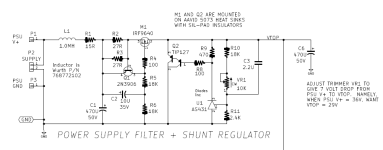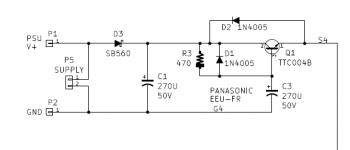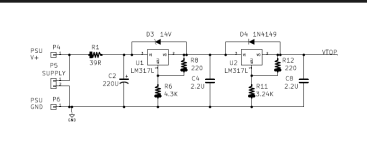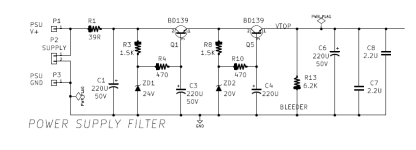@Nelson Pass had mentioned that if enuf people were interested in the F5M PS being made available it could happen. From what I could glean this PS is a good option for many of the projects?
If that's the case perhaps this could serve as a place for people to express their interest.
If that's the case perhaps this could serve as a place for people to express their interest.
Seconded.
The DIYStore board does seem quite expensive given that many might opt to only use part of it.
Perhaps worth also noting Mark Johnson's post #501 on the F5m thread and Nelson's comment (post #686) about using higher power thermistors when operating at higher bias.
The DIYStore board does seem quite expensive given that many might opt to only use part of it.
Perhaps worth also noting Mark Johnson's post #501 on the F5m thread and Nelson's comment (post #686) about using higher power thermistors when operating at higher bias.
The Universal Power Supply boards definitely allow for a number of different configurations, including both CRC and CLC options. They look like they take more floor space inside a chassis; that is the tradeoff.
The newer PS boards are somewhat limited by the diameter of capacitors that are supported, but the PCB size may be well suited to a dual-mono construction. The use of thermistors in place of the middle R or L element must be carefully considered according to the needs of the channel boards. Being on the secondary side of the power transformer, they must handle much larger current than those we normally use on the primary side for inrush current limiting.
Both types of PS boards have useful applications. It would be nice to be able buy the new PS boards independently of the F5m channel boards.
The newer PS boards are somewhat limited by the diameter of capacitors that are supported, but the PCB size may be well suited to a dual-mono construction. The use of thermistors in place of the middle R or L element must be carefully considered according to the needs of the channel boards. Being on the secondary side of the power transformer, they must handle much larger current than those we normally use on the primary side for inrush current limiting.
Both types of PS boards have useful applications. It would be nice to be able buy the new PS boards independently of the F5m channel boards.
This might be a good project to help members make the transition from "somebody please lay out a PCB for me!" to "I have laid out this PCB for everybody, please enjoy!".
Figure out a design, either by yourself or in cooperation with others, download some PCB layout software, and create a board. Upload its Gerber files here then (encourage diyAudio members to order boards from online PCB fabs) -- using your Gerber files. You'll grow as a DIY hobbyist, you'll have a lot of fun, and you'll make a lot of diyAudio members happy.
Figure out a design, either by yourself or in cooperation with others, download some PCB layout software, and create a board. Upload its Gerber files here then (encourage diyAudio members to order boards from online PCB fabs) -- using your Gerber files. You'll grow as a DIY hobbyist, you'll have a lot of fun, and you'll make a lot of diyAudio members happy.
Way beyond my level at this point, but someday. On the topic of PS, I recall reading that amplifiers prefer a stiff power supply for some stages and not for others???
Voltage supplies should always be as constant, and as low impedance, as possible given the cost/size/heat constraints. Guitar amplifier builders may have different preferences.
Reading NP's power supply commentary he says, "A far less expensive approach achieves some of the regulation goals, and that is to regulate or otherwise isolate the low power front end of the amplifier, leaving the output stage looking at an unregulated supply." Doesn't this suggest that having stiff to the front end and soft to the OP is desirable?
People enjoy simple and cheap. Simple and cheap DIY projects are much more likely to be attempted and completed successfully. Is powering a front end from the same supply as the output stage "good enough"?? Usually yes by many standards, and it's simple and cheap, works fine. Simple "RC" filtering on the front end voltage rails can be acceptable regarding noise levels and performance.
Do I believe a well regulated front end with voltage rails 5 to 10 volts higher than the output stage to be desirable and "better"? Yes. Is this more trouble and expense for some small (maybe tiny) performance gain? Yes. Is it "worth it"? Obviously opinions are going to vary... Beauty of DIY is you get to do what YOU think is best and right for your own situation with stuff like this. I like mono block amplifiers; some people say that's a total waste.... people say lots of things don't they?
Do I believe a well regulated front end with voltage rails 5 to 10 volts higher than the output stage to be desirable and "better"? Yes. Is this more trouble and expense for some small (maybe tiny) performance gain? Yes. Is it "worth it"? Obviously opinions are going to vary... Beauty of DIY is you get to do what YOU think is best and right for your own situation with stuff like this. I like mono block amplifiers; some people say that's a total waste.... people say lots of things don't they?
What is certainly not advisable is to try just adding regulation to the front end of an existing design without understanding its ramifications.
For example, don't do it with an F5. 🙂
For example, don't do it with an F5. 🙂
Well, I mess with Papa’s designs on occasion, and I also know better than to inject regulators where they don’t belong.
I certainly didn't mean to say that one shouldn't experiment or try modifications, but rather that they need to be done with care.
Perhaps one or two of the supply filter circuits that are included directly upon the interchangeable front-end cards for the Ship Of Theseus power amplifier, might give DIYers some ideas or germs-of-ideas. Of course you'll want to modify these, to personalize them so they are optimum for your particular environment, with your particular supply voltage(s), your load currents (drawn by your front end), and your available heatsinking.
_
_
Attachments
The circuits shown by Mark Johnson are great examples of well-executed line-level regulators (& capacitance multipliers) that have worked very well in various Sony VFET amp front-ends. They are worth some serious study.
That's true, but....I have noticed that sometimes I like the single transformer approach and its effect on smaller class A amps like these First Watt clones.For every a$$ a seat 🙂 As long as its fun and no one tells me what I like I'm pretty happy. My experience, pretty much all based on listening, is mono blocks can offer better soundstage and imaging, both of which are highly desirable to me.
At another members idea, I took my M2 and my Aleph J and removed one board from each and mixed them. Now, each amp has one M2 board and one Aleph J board, A switch shifts the power supply from one board, or the other.
Then, at the flip of two switches, I had either M2 or Aleph J mono blocks. Yes, tighter, perhaps a little larger sound stage, but something was missing.
Maybe the slightly less Iron claw power supply situation of the single transformer was allowing a bit more warmth and euphonics?
I dont know, but what I do know is I changed them both back to stereo amplifiers and havent had a desire to go back. Something to consider. I suppose those with slightly more difficult to drive speakers may enjoy improvement, but I like Zenmod's take of making the adjustment at the speaker end of the system, the higher the efficiency the better!
Russellc
- Home
- Amplifiers
- Pass Labs
- PS At Store





